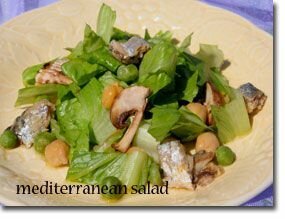If you don't know what to serve for dinner tonight ...
Salad lunches are popular along the Mediterranean. They make a complete meal that will carry you through until dinner. The combination of ingredients in this salad can be changed to suit your personal taste. Enjoy!

Ingredients:
- 6 cups chopped romaine lettuce
- 1/3 of a 3.75 oz can sardines, packed in water
- 1/4 cup crimini mushrooms, sliced
- 1/2 cup cooked garbanzo beans or canned (no BPA)
- 1/4 cup frozen peas
- Dressing
- 1 TBS exra virgin olive oil
- 1 clove garlic, chopped or pressed
- 1 tsp lemon juice
- Place lettuce in large bowl and top with remaining ingredients and dressing.
In-Depth Nutritional Profile for Mediterranean-Style Salad
Healthy Food Tip
Do I have to eat my vegetables raw to attain the full nutritional benefit of the food?
No. Although it would be necessary to eat your vegetables raw in order to prevent any loss of nutrients whatsoever, I believe that it is possible to get the full, practical nutritional benefits from a food that has been cooked, provided that the cooking method is uniquely matched to the food and exposes the food to minimal damage. Here's my thinking:
While most animals thrive on diets consisting almost exclusively of raw, uncooked food, few human cultures have evolved or been sustained without incorporating some cooked foods, including cooked vegetables, into their eating practices. In the case of some vegetables, cooking can actually enhance the variety of nutrients that get released inside our digestive tract. The cooking of onions and garlic are good examples. Onions and garlic are both members of the Allium family of vegetables. Most vegetables in this family have unusual amounts of sulfur-containing compounds that can help protect our health. Heat can actually increase the variety of sulfur-containing substances found in onions and garlic since it triggers chemical reactions that create variations in those sulfur compounds.
Cooking each food properly is essential
Food research has made it clear that even 30 seconds in steam will
alter the nutrient composition of a vegetable and will cause some loss
of nutrients. However, when the exposure to steam happens for such a
short time, this loss of nutrients is minimal and is not, in my opinion,
a practical problem. What I believe is critical, however, is to treat
every vegetable as a unique food, which has its own unique cooking
requirements. To avoid unnecessary nutrient loss, cooking each food
properly is absolutely essential. Five extra minutes of cooking can make
an enormous difference in the nutritional quality of a meal. (This is
about the time it takes to walk away from the stove, answer the phone,
and say that you can't talk right now because you are in the middle of
cooking.)In addition, every food is unique and should be treated that way when it comes to cooking temperatures and times. For example, to preserve its nutrients, spinach should not be boiled for more than one minute. Kale, on the other hand, needs to steam for 5 minutes for proper nutrient availability. The write-ups for each food included in The World's Healthiest Foods book explain just how to cook each food to retain its nutritional benefits. The directions for each recipe are tailored to meet the cooking requirements of the ingredients being used.
Excessive cooking equals nutrient loss
The traditional rules about heat, water, time, and nutrient loss are
all true. The longer a food is exposed to heat, the greater its nutrient
loss. Boiling foods (submersing a food in boiling water) results in
more nutrient loss than steaming (surrounding a food with steam), if all
other factors are equal. The lower nutrient loss from steaming is the
main reason this method of cooking is so often recommended in our
recipes. No valid reason exists to expose food to high heat and boiling
water for any prolonged period of time; even butternut squash can be
fully cooked when steamed for 7 minutes if cut into small pieces!
Raw vegetables may not always be best
Even when eating raw vegetables, other factors must be considered
when evaluating the nutritional quality of the food. How fresh is the
raw vegetable? Significant nutrient loss occurs in raw vegetables if
they have been picked too long before they are eaten and have been
exposed too long to light and air. How well will you chew the raw
vegetables before swallowing them? When a food is not cooked, the body
depends much more heavily upon chewing to help prepare the vegetable for
digestion. Cooking a vegetable, even for a very short period like one
minute, can sometimes become a way of enhancing its digestibility.
Practical Tips
I encourage you to enjoy both raw and cooked vegetables in your
Healthiest Way of Eating. By chewing well and savoring the tastes and
textures of your raw food and by following my cooking suggestions that
make the most of each food's unique cooking requirements, you will get
optimal nutritional benefits from both!

No comments:
Post a Comment